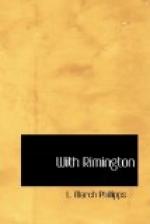One point of difference, I notice, so far as a short experience goes, between cavalry and infantry, which is all in favour of the cavalry; and that is, that when they get into fire the infantry go calmly on, while the much wiser cavalry generally run away. We retired from these guns, but when opposite the corner of the range the Lancers got on to some bad ground in front of us, and we had to halt a minute, which gave the Boer Long Tom an excellent chance of a few parting words with us. The first shell came along, making the mad noise they do, whooping and screaming to itself, and plunged into the ground with a loud snort only about thirty or forty yards off. The gunner, having got his range, was not long in sending down another, and when the white curl of smoke appeared lying again on the hillside, one guessed that the individual now on his way would prove a warmish customer. It burst with a most almighty crack, and I involuntarily bent down my head over my horse’s neck. “Right over your head,” shouted the next man, in answer to my question as to where it burst.
If you are at all interested in “projectiles,” you may care to hear that shrapnel is most effective when it bursts over, but a little short of, the object aimed at; the bullets, released by the bursting charge, continuing the line of flight of the shell, which is a downward slant. There is a rather anxious interval, of about ten or fifteen seconds generally after you see the smoke of the gun, and before anything else happens. Then comes the hollow boom of the report, and almost immediately afterwards the noise of the shell, growing rapidly from a whimper to a loud scream, with a sudden note of recognition at the end, as if it had caught sight of and were pouncing on you. It is a curious fact, however, that, in spite of the noise they make, you cannot in the least distinguish in which direction they are coming. You find yourself looking vaguely round, wondering where this yelling devil is going to ground, but till you see the great spurt of earth you have no idea where it will be. We came back across the plain, having more or less located the position and the guns. Rimington with one squadron got into a tight place among some kopjes on our right. The rifle fire was very hot, and at close range. The Major took up his orderly, whose horse was shot, on his own pony, and brought him off. For a moment the squadron came under cover of a hill, but they had to run the gauntlet of the Boer fire to get away. Rimington laughingly asked for a start as his pony was carrying double, and rode first out into the storm of bullets. Several men and horses were hit, but no men killed, and they were lucky in getting off as cheap as they did. We then drew back to a cattle kraal on the slope overlooking the plain, from which we watched the development of the infantry attack.
I usually carry a note-book and pencil in my pocket, partly to jot down any information one may pick up at farms from Kaffirs, &c., and partly to make notes in of the things I see. Here is a note from the kraal.




